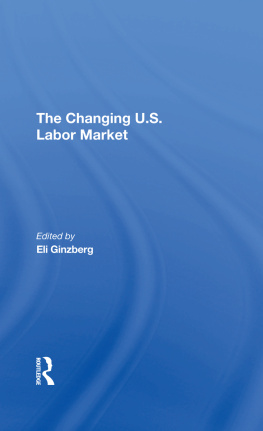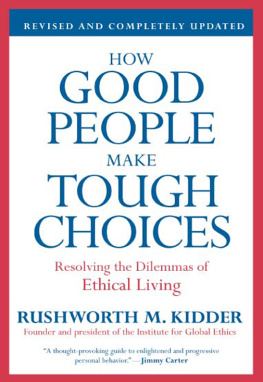Does Job Training Work?
Conservation of Human Resources Studies in the New Economy
Does Job Training Work? The Clients Speak Out, Eli Ginzberg, Terry Williams, and Anna Dutka
New York's Financial Markets: The Challenges of Globalization, edited by Thierry Noyelle
Immigrant and Native Workers: Contrasts and Competition, Thomas R. Bailey
Beyond Industrial Dualism: Market and Job Segmentation in the New Economy, Thierry J. Noyelle
Computerization and the Transformation of Employment: Government, Hospitals, and Universities, Thomas M, Stanback, Jr.
Technology and Employment: Concepts and Clarification, Eli Ginzberg, Thierry J. Noyelle, and Thomas M. Stanback, Jr.
First published 1989 by Westview Press
Published 2018 by Routledge
52 Vanderbilt Avenue, New York, NY 10017
2 Park Square, Milton Park, Abingdon, Oxon OX14 4RN
Routledge is an imprint of the Taylor & Francis Group, an informa business
Copyright 1989 by Conservation of Human Resources, Columbia University
All rights reserved. No part of this book may be reprinted or reproduced or utilised in any form or by any electronic, mechanical, or other means, now known or hereafter invented, including photocopying and recording, or in any information storage or retrieval system, without permission in writing from the publishers.
Notice:
Product or corporate names may be trademarks or registered trademarks, and are used only for identification and explanation without intent to infringe.
Library of Congress Cataloging-in-Publication Data
Ginzberg, Eli, 1911
Does job training work?
(Conservation of Human Resources studies in the
new economy)
1. Occupational trainingPennsylvaniaPhiladelphia
Metropolitan Area. I. Williams, Terry M. II. Dutka,
Anna B. III. Title. IV. Series.
HD5715.4.P5G56 1989 331.25'92'0974811 88-36277
ISBN 13: 978-0-367-00346-3 (hbk)
When the senior author of this book, Eli Ginzberg, asked me to write a foreword, I accepted with enthusiasm and a firm sense of purpose. My conviction about the importance of this work stems from the fact that, despite more than $100 billion spent on employment and training from 1962 to 1982, no one has ever talked to the customerspotential and actualabout their views of its effectiveness and relevance to their lives.
In my first year as President and CEO of the Philadelphia Private Industry Council (PIC), I defined our customersboth trainees and employersas critical constituents for our work. Later in this foreword, I will describe what we learned about our customers in 1985, and what we did in response to their views of publicly financed employment and training work.
The seed for this book was planted in the Spring of 1987. At that time, the Philadelphia PIC ranked number one on four of the seven performance standards mandated by the Commonwealth of Pennsylvania. We at the PIC were doing very well, but I wanted to learn more about the trainees' decisions to participate in our programs. That decision, when positive, led to effective job placements and helped each person get on a path toward self-sufficiency. When negative, another person stood outside the local employment and training system and was still dependent on the direct and indirect income from welfare. In this context, I asked Eli Ginzberg and his colleaguesTerry Williams and Anna Dutkato construct a research design which would answer the question, Why does a person participate in a program? Also, what factors positive or negativeinfluenced this decision?
This book reports the findings of a 1987 survey of our customers. Paying attention to our customers is not a new phenomenon. In fact, this interest led, in the Spring of 1985, to a survey which has had lasting effects on our operational practices. I have summarized in the following paragraphs the key findings from PIC's 1985 customer survey.
In 1985, the Philadelphia PIC defined itself as a "training-based bridge" which connects motivated, interested people with employers who want to hire productive, effective employees. As a training-based bridge, PIC has two key customersthe trainees and the employers. Both customers count, but each has its own particular needs. The PIC pays attention to our trainees' needs by developing and implementing programs and services which respond to them. Our employment and training business is set up to deliver productive, effective people to our employer-customers. Although most successful private sector businesses endeavor to be customer-sensitive, most, if not all, employment and training organizations rarely think along these lines. Even when they do, their interest is focused primarily on the trainee. At the Philadelphia PIC, we focus on both customers. We need the trainee and the employer to have a successful, well-functioning employment and training system and business. Exclusive focus on one alone does not lead to an effective delivery system.
If we need both the trainee and the employer, then we must ask, "What do our customers want from the PIC?" When we asked our trainees, they said:
- First, they wanted the payoff of a job. For them, that was the real test of the value of any training program. Would the training lead to a job?
- Second, they sought quality and dependability. They favored programs where they learned marketable skills and could depend on the training provider to work with them and assist them with their job search activities.
- Third, they preferred the location of the training site to be near their residence. Most Philadelphians have a strong preference for living, training, and working in the same community.
- Fourth, they insisted on a reduction in the number of problems confronted during the process of enrolling in a program. Also, they requested a reduction in the time between a trainee's expression of interest in a program and enrollment.
From our trainees' perspective, these four "wants" represented "make or break" factors for their participation in a PIC-sponsored program.
In a similar manner, we asked our employers the same question. Their responses were:
- First, they are interested in hiring productive, effective people people who can "do a job."
- Second , all new hires must have sound basic skillsreading, math, and English language skills at an eighth grade level.
- Third, they prefer people who have good work habits and a positive attitude toward work. It is a major plus if a person can work effectively alone or as a member of a work team.
- Fourth, they disliked an approach to employers which over-emphasized their social responsibility. They were interested in new hires who could do a job and wanted to work with PIC on that basis.
For employers and trainees alike, it is important to ask, "What do you want?" In the asking of the question, we have learned much about our customers. This learning has caused us to refine and fine tune our operations, and to work differently. Of equal importance is PIC's responsethe delivery of programs and services. Having asked the question of our customers, what did PIC intend to do about their respective and well-defined needs?
Listening to our customers has led the Philadelphia PIC to take new and different approaches to employment and training work. Some of our new initiativesresponsive to our trainees' needsinclude:












